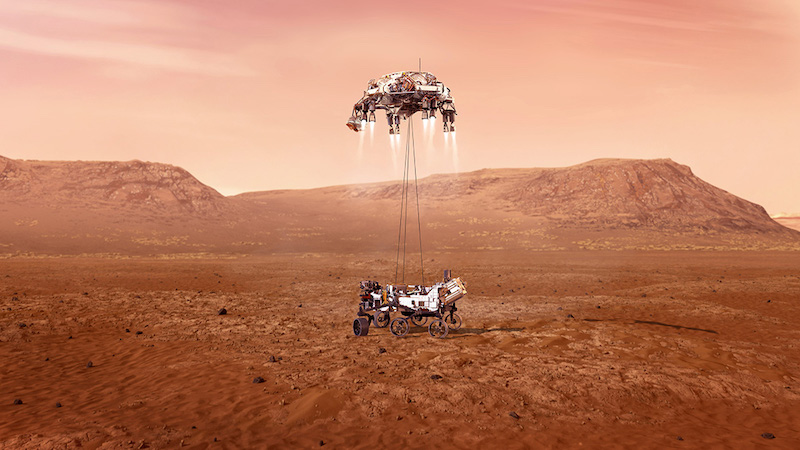
NASA will use a “sky crane” to gently lower Perseverance to the surface of Mars. Artist’s concept via NASA.
Landing on Mars is hard. So you’ll want to watch on February 18, 2021, when Perseverance (formerly called Mars 2020) hopefully becomes the first artificial object to land on the red planet since the Mars Insight lander in 2018. It’ll be the first rover since Curiosity touched down in 2012. Due to land in the Jezero Crater, just north of Mars’ equator, Perseverance carries a slew of science instruments to collect soil samples and search for signs of ancient life. It’s equipped with advanced audio-visual technology to let us see and hear – for the first time ever – what it’s like to touch down on another world. It’ll be exciting! NASA TV’s live coverage of the event will begin on February 18 at 2:15 p.m. EST (19:15 UTC); the landing will take place at approximately 3:55 p.m. EST (20:55 UTC). Watch here.
The 2021 lunar calendars are here. A few left. Order yours before they’re gone!
Innovative cameras and microphones on Perseverance will capture much of its pivotal entry, descent, and landing process. This process, sometimes referred to by space engineers as seven minutes of terror, is considered by many to be the most critical and dangerous part of the mission. The rover will hit the Martian atmosphere traveling at almost 12,000 miles per hour (19,312 kmh), streaking across the sky as its protective heat shield helps to slow it down. Then, at an altitude of about 1 mile (1.5 km), the descent module will fire its engines, while a new terrain relative navigation system will kick in to identify a safe landing spot. Essentially, it will scan and analyze the terrain below, then match it up with maps in its database and prepare for touchdown.
A 70-foot (21 m) diameter parachute will deploy to slow the craft further, bringing all systems to a crawl, before the sky crane begins its task of lowering the rover the rest of the way to the ground. The sky crane is the same hovering-landing system used by Curiosity, and is a completely autonomous system designed to give rovers a soft, gentle landing (hopefully).
Design-wise, the rover is very similar to the Curiosity rover, currently in Gale Crater, but has some different science instruments. While Curiosity focuses on finding evidence of past habitability, which it has done, Perseverance is looking for direct evidence of life itself. This will be the first mission since the Viking 1 and 2 landers in the late 1970s/early 1980s to do so.
Perseverance’s flashy new cameras will capture much of this entire process. A camera mounted on the back shell of the spacecraft is pointed upward. That will record a view of the parachutes deploying as it slows to land. Then, beneath it is a downward-pointing camera on the descent stage, which will film its first touch-contact with the ground on Mars. This suite of technology will provide us with the most detailed video and photo records of landing on a neighboring world yet. Lori Glaze, who heads the Planetary Science Division of NASA’s Science Mission Directorate, told reporters:
We’re going to be able to watch ourselves land for the first time on another planet.
There won’t, however, be a livestream of the footage, as we’re accustomed to with International Space Station events and rocket launches from Earth. The reason for this is due to a lag in data relay from Mars to Earth, which is slower than even old dial-up connections. But we may get a glimpse of Perseverance on the ground using the Mars Reconnaissance Orbiter, which can share at least low-resolution images with us shortly after landing. Moreover, we will also have live feeds from mission control at NASA’s Jet Propulsion Laboratory in Pasadena, California. Footage from the Curiosity landing has left us with some iconic images (enter Bobak Ferdowsi). Of course, coronavirus protocols will still be in effect at mission control, but it’s unlikely that even a pandemic will dampen the celebration. Perseverance deputy project manager, Matt Wallace, has said:
I don’t think that Covid is going to be able to stop us from jumping up and down and fist bumping. You’re going to see a lot of happy people no matter what, once we get this thing on the surface safely.

Researchers in NASA-JPL’s main mission control, celebrating Curiosity’s 2012 landing. Bobak Ferdowsi, a systems engineer, pictured on the left, was made famous in other shots for his signature mohawk. Image via NASA/ Daily Mail.
To date, there’ve been only eight successful Mars landings: Viking 1 and Viking 2 (both 1976), Pathfinder (1997), Spirit and Opportunity (both 2004), Phoenix (2008), Curiosity (2012) and InSight (2018).
The Soviet Union is the only other country to land a spacecraft on Mars successfully. That was in 1971 and 1973.
On the other hand, once they get there, Mars missions may last for years, and robot rovers from Earth have spent years rolling around Mars. With the Perseverance mission, for the first time ever, NASA will try something new; it’ll release a small helicopter into the thin Martian air. The helicopter is called Ingenuity. It’ll attempt to scout around the small planet, trying to target locations of interest for future Mars missions.
NASA chose Jezero Crater as the landing site for the Perseverance rover with good reason. Scientists believe the area was once flooded and home to an ancient water river delta more than 3.5 billion years ago. River channels spilled over the crater wall and created a lake, carrying clay minerals from its surroundings. Microbial life could have lived in the crater during one or more of these wet periods, and if so, signs of their remains might be found in lakebed or shoreline sediments. Scientists will study how the region formed and evolved, seek signs of past life, and collect samples of Mars rock and soil that might preserve these signs. The process of landing site selection involved mission team members and scientists from around the world, who carefully examined more than 60 candidate locations. But after the exhaustive five-year study of potential sites, each with its own unique characteristics and appeal, Jezero rose to the top.
In preparation for Perseverance’s landing, NASA is offering landing resources, ways to participate, social opportunities, and more. Download posters, stickers, fact sheets, mission patches, and more. Register for a virtual landing event, where you can connect online with other space enthusiasts and ask NASA experts your most burning questions. Get lessons and activities for students, or even stamps for virtual passports, all available via their website here.
Bottom line: Due to land in the Jezero Crater on February 18, 2021, NASA’s Perseverance rover will carry science instruments to collect soil samples and look for signs of ancient life. It will also use audio-visual technology to let us see and hear what it’s like to touch down on another world for the first time ever. NASA TV’s live coverage of the event will begin that day at 2:15 p.m. EST (19:15 UTC); landing at approximately 3:55 p.m. EST (20:55 UTC).
Read more from CNET: NASA Mars Perseverance rover: What to expect on landing day
Hot Wheels Perseverance lands in stores ahead of rover on Mars

https://ift.tt/36TEXIS
Science
No comments:
Post a Comment